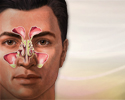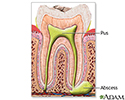Face pain
Face pain may be dull and throbbing or an intense, stabbing discomfort in the face or forehead. It can occur in one or both sides.
Causes
Pain that starts in the face may be caused by a nerve problem, injury, or infection. Face pain may also begin in other places in the body.
-
Abscessed tooth (ongoing throbbing pain on one side of the lower face that gets worse with eating or touching)
Abscessed tooth
A tooth abscess is a pocket of pus caused by a bacterial infection.
 ImageRead Article Now Book Mark Article
ImageRead Article Now Book Mark Article -
Cluster headache
Cluster headache
A cluster headache is an uncommon type of headache. It is one-sided head pain that may involve tearing of the eyes, a droopy eyelid, and a stuffy no...
 ImageRead Article Now Book Mark Article
ImageRead Article Now Book Mark Article -
Herpes zoster (shingles) or herpes simplex (cold sores) infection
Herpes zoster
Shingles is a painful, blistering skin rash. It is caused by the varicella-zoster virus, a member of the herpes family of viruses. This is the viru...
 ImageRead Article Now Book Mark Article
ImageRead Article Now Book Mark Article - Injury to the face
-
Migraine
Migraine
A migraine is a type of headache. It may occur with symptoms such as nausea, vomiting, or sensitivity to light and sound. In most people, a throbbi...
 ImageRead Article Now Book Mark Article
ImageRead Article Now Book Mark Article - Myofascial pain syndrome
-
Sinusitis or sinus infection (dull pain and tenderness around the eyes and cheekbones that gets worse when you bend forward)
Sinusitis
Sinusitis is present when the tissue lining the sinuses become swollen or inflamed. It occurs as the result of an inflammatory reaction or an infect...
 ImageRead Article Now Book Mark Article
ImageRead Article Now Book Mark Article -
Tic douloureux (trigeminal neuralgia)
Tic douloureux
Trigeminal neuralgia (TN) is a nerve disorder. It causes a stabbing or electric shock-like pain in parts of the face.
 ImageRead Article Now Book Mark Article
ImageRead Article Now Book Mark Article - Temporomandibular joint dysfunction syndrome
Sometimes the reason for the face pain is unknown.
Home Care
Your treatment will be based on the cause of your pain.
Painkillers may provide temporary relief. If the pain is severe or does not go away, contact your health care provider or dentist.
When to Contact a Medical Professional
Contact your provider if:
- Face pain is accompanied by chest, shoulder, neck, or arm pain. This could mean a heart attack. Call 911 or your local emergency number.
Heart attack
Most heart attacks are caused by a blood clot that blocks one of the coronary arteries. The coronary arteries bring blood and oxygen to the heart. ...
 ImageRead Article Now Book Mark Article
ImageRead Article Now Book Mark Article - Pain is throbbing, worse on one side of the face, and aggravated by eating. Contact a dentist.
- Pain is persistent, unexplained, or accompanied by other unexplained symptoms. Contact your primary provider.
What to Expect at Your Office Visit
If you have an emergency condition (such as a possible heart attack), you will first be stabilized. Then, the provider will ask about your symptoms and medical history and do a physical exam. You will be referred to a dentist for tooth problems.
You may have the following tests:
-
Dental x-rays (if a tooth problem is suspected)
Dental x-rays
Dental x-rays are a type of image of the teeth and mouth. X-rays are a form of high energy electromagnetic radiation. The x-rays penetrate the body...
 ImageRead Article Now Book Mark Article
ImageRead Article Now Book Mark Article -
ECG (if heart problems are suspected)
ECG
An electrocardiogram (ECG) is a test that records the electrical activity of the heart.
 ImageRead Article Now Book Mark Article
ImageRead Article Now Book Mark Article -
Tonometry (if glaucoma is suspected)
Tonometry
Tonometry is a test to measure the pressure inside your eyes. The test is used to screen for glaucoma. It is also used to measure how well glaucoma...
 ImageRead Article Now Book Mark Article
ImageRead Article Now Book Mark ArticleGlaucoma
Glaucoma is a group of eye conditions that can damage the optic nerve. This nerve sends the images you see to your brain. Most often, optic nerve da...
 ImageRead Article Now Book Mark Article
ImageRead Article Now Book Mark Article -
X-rays of the sinuses
X-rays of the sinuses
A skull x-ray is a picture of the bones surrounding the brain, including the facial bones, the nose, and the sinuses.
 ImageRead Article Now Book Mark Article
ImageRead Article Now Book Mark Article
Neurological tests will be performed if nerve damage could be a problem.
References
Garza I, Robertson CE, Smith JH, Whealy MA. Headache and other craniofacial pain. In: Jankovic J, Mazziotta JC, Pomeroy SL, Newman NJ, eds. Bradley and Daroff's Neurology in Clinical Practice. 8th ed. Philadelphia, PA: Elsevier; 2022:chap 102.
Digre KB. Headaches and other head pain. In: Goldman L, Cooney KA, eds. Goldman-Cecil Medicine. 27th ed. Philadelphia, PA: Elsevier; 2024:chap 367.
-
Tooth abscess - illustration
A collection of infected material (pus) resulting from bacterial infection of the center (pulp) of a tooth.
Tooth abscess
illustration
-
Pain of cluster headache - illustration
The symptoms of a cluster headache include stabbing severe pain behind or above one eye or in the temple. Tearing of the eye, congestion in the associated nostril, and pupil changes and eyelid drooping may also occur.
Pain of cluster headache
illustration
-
Tooth abscess - illustration
A collection of infected material (pus) resulting from bacterial infection of the center (pulp) of a tooth.
Tooth abscess
illustration
-
Pain of cluster headache - illustration
The symptoms of a cluster headache include stabbing severe pain behind or above one eye or in the temple. Tearing of the eye, congestion in the associated nostril, and pupil changes and eyelid drooping may also occur.
Pain of cluster headache
illustration
Review Date: 7/8/2023
Reviewed By: Linda J. Vorvick, MD, Clinical Professor, Department of Family Medicine, UW Medicine, School of Medicine, University of Washington, Seattle, WA. Also reviewed by David C. Dugdale, MD, Medical Director, Brenda Conaway, Editorial Director, and the A.D.A.M. Editorial team.



